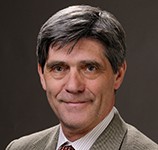They are present in devices used in widely practiced medical procedures with the aim of treating or diagnosing health problems. They become part of the human body, temporarily or permanently, and interact, in a more or less active manner, with the biological system in which they are inserted. Obviously, we are talking about biomaterials. Examples of devices made of biomaterials are quite numerous. We can mention, among many others, stents that release drugs to achieve best results in the opening of arteries that are becoming blocked, and orthopedic implants that promote the regeneration of the bone tissue they are temporarily replacing.
 Biomaterials is the subject of the XIV SBPMat Meeting´s plenary lecture that will be given by Paul Ducheyne. In the talk, Ducheyne will address, in particular, two kinds of biomaterials: bioactive ceramics with in situ functionalization, and sol-gel nanoporous materials that delivery drugs and other molecules.
Biomaterials is the subject of the XIV SBPMat Meeting´s plenary lecture that will be given by Paul Ducheyne. In the talk, Ducheyne will address, in particular, two kinds of biomaterials: bioactive ceramics with in situ functionalization, and sol-gel nanoporous materials that delivery drugs and other molecules.
Ducheyne is a Professor of Bioengineering and of Orthopaedic Surgery Research at the University of Pennsylvania (Penn), United States. He is also Director of the Center for Bioactive Materials and Tissue Engineering, a group of multidisciplinary research that brings together scientists from the Engineering, Dentistry and Medicine Departments at Penn. Besides, Ducheyne is a Special Guest Professor at the University of Leuven (KU Leuven), Belgium, where he obtained his MSc and PhD degrees in Materials Science and Engineering.
Paul Ducheyne is the author or editor of a number of books on biomaterials; in particular, he is editor in chief of “Comprehensive Biomaterials,” a 3,650 paged book divided into six volumes, published in 2011 by Elsevier publisher. Owner of a 58 H index, he has published about 330 scientific papers with more than 10,000 citations – of which some 2,600 belong to his 10 most cited articles. Ducheyne has also authored over 40 patents. In addition, from the 1980s on, he has organized several conferences and symposia in biomaterials.
In 1992, Ducheyne founded the company Orthovita, dedicated to products for treating injured bones and for controlling bleeding, and he was its CEO until 1999. In 2011, the company became part of Stryker Corporation, one of the leaders in the market of technology for medicine.
Paul Ducheyne was Secretary of the European Society for Biomaterials, and President of the US Society for Biomaterials and the International Society for Ceramics in Medicine. Among other awards and distinctions, in 2008 he won the C. William Hall Award of the Society for Biomaterials. Ducheyne was or is still part of the editorial boards of scientific journals in the fields of Biomaterials, Bioceramics, Bioengineering, Tissue Engineering, Orthopedics and Dentistry.
What follows is a mini-interview with this scientist.
SBPMat newsletter: – Could you briefly tell us what led you to devote to research on biomaterials?
Paul Ducheyne: – I was always attracted to medicine. In addition – when I graduated (in the seventies) – I foresaw the decline of the steel industry in the West, and I did not want to be caught into this. Therefore, my radical turning away from the then current materials science.
SBPMat newsletter: – How were you able to merge Materials Science and Biology in your scientific career?
Paul Ducheyne: – It is THE central theme in Biomaterials research.
SBPMat newsletter: – In your opinion, what are your most significant contributions in the field of biomaterials? Please explain them, very briefly, and share references from the resulting articles or books, or comment if these studies have produced patents, products, spin-off companies etc.
Paul Ducheyne: – Most people will know my mechanistic explanation for how synthetic materials (ceramics) stimulate cell function and lead to tissue formation. More recently, my using sol gel processed ceramics for controlled relase of a plethora of drugs and growth factors is also highly regarded. Lastly, I have published papers on a number of subjects (such as bone tissue ingrowth in porous materials, bone cement mechanical behavior, and titanium biocompatibility) which are highly cited.
More
- Prof. Paul Ducheyne bio: http://sbpmat.org.br/14encontro/plenary-speakers/Bio-Ducheyne.pdf
- Abstract of the plenary talk: http://sbpmat.org.br/14encontro/plenary-speakers/Abstract-Ducheyne.pdf
